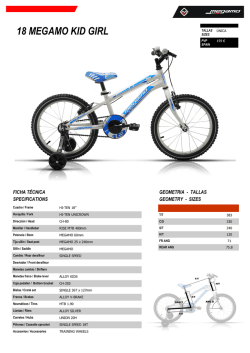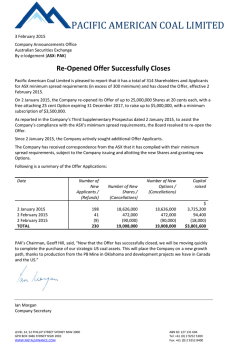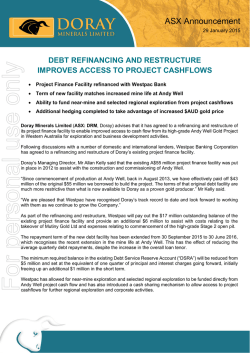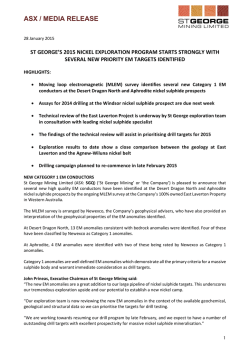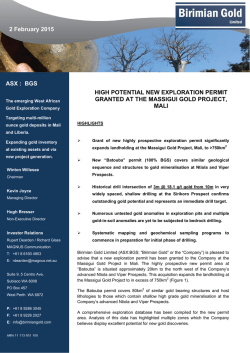
New Project secured for 2015
Exciting New Exploration Project Secured for 2015 SUMMARY ABN 20 109 361 195 ASX Release 28 January 2015 Alloy Resources Ltd Suite 6, 7 The Esplanade Mount Pleasant WA 6153 Tel: +61 8 9316 9100 Fax: +61 8 9315 5475 Email: [email protected] Website: www.alloyres.com Directors Executive Chairman: Andy Viner Non-Exec Director Andre Marschke Non-Exec Director/Co Sec: Kevin Hart Alloy Resources Limited (ASX:AYR, Alloy or the Company) is pleased to advise that it has secured an Option over the Martin’s Well Project which provides Alloy with access to an exciting goldsilver-copper project with walk up drill targets on 2km of outcropping quartz-veined gossans. Alloy has reviewed a large number of projects in the last 6 months with the view to finding a project to complement our existing Horse Well gold project which is being funded and managed by Doray Minerals Limited. Martin’s Well meets the Company’s criteria of a low cost entry, high potential and drill ready targets and the ability to undertake a quick and cost effective assessment with the potential for a significant new discovery. MARTINS WELL PROJECT – SOUTH AUSTRALIA The project is located in South Australia where the Company has secured through application an 848 square kilometre Exploration Licence (No. 2014/00205) containing; • Approximately 2 strike kilometres of outcropping quartzveined iron gossans with widths of 5 to 20 metres. • Mineralogical studies by Dr Ben Grguric of Mineralium Pty Ltd confirms these to be pyrite-derived iron rich outcrops (‘gossans’). • Historical rock chip grab sampling results show consistent anomalous values of 0.1 to 0.5% Copper. • Massive botryoidal to mammillary goethite formation dominates the gossans and later silicification is common indicating highly acidic leaching has occurred in the weathered zone. • Unverified historical shaft (1892) sampling is recorded as locating a 0.8 metre wide ‘quartz lode’ sample containing 16% metallic Copper, 166 oz/t Silver and 0.5 oz/t mill-able Gold at 90 feet (30 metres) in a cross-cut through the structure. • Located in the eastern Flinders Ranges region Issued Capital Shares: 489,582,646 Unlisted Options: 33,142,821 ASX Symbol: AYR The Company will apply for grant funding under the South Australian Government’s PACE Frontier co-operative exploration drilling project. Grant funding for up to 50% of direct drilling costs, capped at $100,000, is available for successful applicants. If successful a drilling grant may be secured for the exploration drilling planned for April The Exploration Licence has progressed through the South Australian government system and will likely be granted at the end of February. A fee of $10,000 has been paid to Vendors and further payments will be made upon grant of the Licence and then within 2 years to secure a 90% interest.. Alloy Executive Chairman, Andy Viner, commented “The Company has been actively reviewing numerous project opportunities since the Horse Well Project was farmed-out to Doray Minerals last May, and is now pleased to be able to announce that this exciting new exploration project has been secured. The Martins Well Project ticks all the boxes for what we are looking for including low cost entry, low cost to test a walk-up drill target, and a large gold / copper target. The gossanous structures at the Mammoth Black Ridge prospect are highly anomalous features in this area and appear to be within a regional mineralised corridor containing occurrences of copper-gold-silver-zincbarite and manganese which may suggest we are within a larger mineralised system”, he said Figure 1 The prominent outcropping Mammoth Black Ridge structure Figure 2 Copper-carbonate (Malachite) forming in caves within the structure at surface AYR ASX Announcement 28 January 2015 Page 2 of 14 Figure 3 Aerial view of highly unusual iron rich structures at Mammoth Black Ridge Previous Exploration The Company has completed a thorough review of historical literature and also completed a field visit to verify aspects of reported activities and evidence of mineralisation. The key feature that has attracted the Company to this project is the association of a historical shaft that was reported to have high grade copper-silver and gold in a narrow quartz lode within a massive iron rich structure, and rock chip sampling by previous companies had indicated associated anomalous copper mineralisation. As shown in Figure 4 below, the historical records that mention the high grade sample at the bottom of the shaft are extremely interesting however they cannot be verified without re-entering the shaft or drilling into the same area. The Company has searched for more detailed reports however they have not been able to be located, and no previous company research has unearthed more details. AYR ASX Announcement 28 January 2015 Page 3 of 14 Figure 4 Historical Records describing the Mammoth Black Ridge location and geology A number of companies have sampled the iron rich outcrops at Mammoth Black Ridge in the last 30 years and all have returned anomalous results of a similar tenor. Only one Company, Strategic Minerals Corporation NL in 2008, provided accurate survey locations of samples, and these have been presented on Figure 5 below and also in Appendix 1. Figure 5 Copper geochemistry from historical rock chip sampling at Mammoth Black Ridge AYR ASX Announcement 28 January 2015 Page 4 of 14 Strategic did not provide sample descriptions or methodology, however it is assumed that samples were ‘grabbed’ from the surface and gold reported as fire assays, and other elements analysed by ICP techniques. Alloy believes that the results may be anomalous and potentially confirm that the iron rich structures may have primary copper –gold and silver mineralisation which has been leached from the surface outcrops. To try and define the nature of the iron outcrops a number of hand specimens were collected from the outcrops and submitted to Dr Ben Grguric of Mineralium Pty Ltd for mineralogical analysis. Background information including historical technical reports, GIS compiled data and photographic evidence was also supplied or shown to Dr Grguric to assist his evaluation. Dr Grguric completed a report for the Company in which he concluded that; • “Mammoth Black Ridge represents a leached gossan after pyrite with some associated Cu (and Au) mineralisation” Figure 6 below shows images of goethite boxworks after pyrite in the samples provided to and reported on by Dr Grguric. Figure 6 Excerpt from Mineralium Pty Ltd report on Mammoth Black Ridge gossans AYR ASX Announcement 28 January 2015 Page 5 of 14 Figure 7 Close-up of botryoidal goethite and quartz veins in outcrop at Mammoth Black Ridge The Company has compiled additional rock chip sampling and stream sampling data from company reports which are still being interpreted prior to any conclusions being made. The South Australian government SARIG online database shows numerous mineral occurrences within the Tenement including small historical Barite and Copper mines and workings as well as gold, manganese and iron occurrences. During field inspection of the Mammoth Black Ridge Prospect, two Diamond Drill hole collar sites were observed with some remnant discarded core around the site. An exhaustive search of Company records has not been able to find any information about these two holes. The current pastoral lease owner was contacted and indicated that the holes were pre-1984 when he assumed ownership. This fact combined with the BQ sized small diameter core recovered, suggests this work was done in the 1970’s. The location of both core hole collars is very odd with respect to the optimal location to drill and intersect the target iron rich structures, and they may have been vertical holes focussed on testing the adjacent stratigraphy for strata-bound mineralisation which was a common geological model at that time. Exploration Plan The Company intends to fast-track Heritage and Environmental access to enable a small focussed RC drill program aimed at testing the extent of base and precious metals at depth within the Mammoth Black Ridge prospect gossans. This is expected to occur in April 2015 Finders Agreement The Terms of the Finders Agreement which was entered into prior to Alloy making the Exploration Licence Application are as follows; 1. Payment of $10,000 within 90 days of making application for an Exploration Licence over the area of interest and electing to pursue grant of the licence. 2. Upon grant of the licence an Initial Payment of $25,000 cash and $25,000 in shares at a price based on the previous 20 day weighted average price. 3. A Second Payment of $50,000 cash and $50,000 in shares at a price based on the previous 20 day weighted average price upon a decision to renew the tenement after 2 years of grant. 4. Alloy must maintain the Tenement in good standing for 2 years, or make all the Payments to earn its 90% interest. 5. Alloy may withdraw at any time and transfer the Tenement to the Vendor. AYR ASX Announcement 28 January 2015 Page 6 of 14 6. Upon Alloy earning its 90% the Vendor will be free-carried to completion of a Bankable Feasibility Study after which the Vendor may elect to contribute or elect to revert to a 1.5% Net Smelter Royalty. For further information contact: Andy Viner Executive Chairman Phone: +61 8 9316 9100 www.alloyres.com Exploration Results The information in this report which relates to Exploration Results is based on information compiled by Andrew Viner, a Director of Alloy Resources Limited and a Member of the Australasian Institute of Mining and Metallurgy, Mr Viner has sufficient experience which is relevant to the style of mineralisation and type of deposit under consideration and to the activity which they are undertaking to qualify as a Competent Person as defined in the 2012 Edition of the “Australasian Code for Reporting of Exploration Results, Mineral Resources and Ore Reserves.” Mr Viner consents to the inclusion in the report of the matters based on this information in the form and context in which it appears. Mr Viner is a shareholder and option holder of Alloy Resources Limited. AYR ASX Announcement 28 January 2015 Page 7 of 14 AYR ASX Announcement 28 January 2015 Page 8 of 14 APPENDIX 2 JORC 2012 Table 1 SECTION 1 SAMPLING TECHNIQUES AND DATA Criteria JORC Code explanation Sampling techniques Nature and quality of sampling (e.g. cut channels, random chips, or specific specialised industry standard measurement tools appropriate to the minerals under investigation, such as down hole gamma sondes, or handheld XRF instruments, etc). These examples should not be taken as limiting the broad meaning of sampling. Include reference to measures taken to ensure sample representivity and the appropriate calibration of any measurement tools or systems used Aspects of the determination of mineralisation that are Material to the Public Report. In cases where ‘industry standard’ work has been done this would be relatively simple (e.g. ‘reverse circulation drilling was used to obtain 1 m samples from which 3 kg was pulverised to produce a 30 g charge for fire assay’). In other cases more explanation may be required, such as where there is coarse gold that has inherent sampling problems. Unusual commodities or mineralisation types (e.g. submarine nodules) may warrant disclosure of detailed information Drilling techniques Drill sample recovery Logging Commentary Historical soil samples are being reported as derived from reports available from the Government of South Australia and contained within the body of the report. Sample locations were recorded by previous workers and have been correlated with current survey datum and are believed to be correct. Soil sample collection methodology is regarded as Industry standard. The methodology used was believed to be by ‘grab’ sampling at regular intervals along outcrop of the target rock type. .No details of particular methodology is available. Conventional Fire Assay and ICP techniques have been reported by previous operators Drill type (e.g. core, reverse circulation, open-hole hammer, rotary air blast, auger, Bangka, sonic, etc) and details (e.g. core diameter, triple or standard tube, depth of diamond tails, facesampling bit or other type, whether core is oriented and if so, by what method, etc). Samples were hand collected without a drill machine. Method of recording and assessing core and chip sample recoveries and results assessed Samples were hand collected without a drill machine. Measures taken to maximise sample recovery and ensure representative nature of the samples Samples were hand collected without a drill machine. Whether a relationship exists between sample recovery and grade and whether sample bias may have occurred due to preferential loss/gain of fine/coarse material. Samples were hand collected without a drill machine Whether core and chip samples have been geologically and geotechnically logged to a level of detail to support appropriate Mineral Resource estimation, mining studies and metallurgical studies. No geological descriptions are recorded in the historical report quoted although samples have been plotted on accurate satellite images and believed to be related the the rock type discussed. Further verification of this is derived from sample descriptions and assays of unlocated samples from the same prospect reported by other company official reports. Whether logging is qualitative or quantitative in nature. Core (or costean, No descriptions to evaluate. channel, etc) photography. Sub-sampling techniques and sample preparation The total length and percentage of the relevant intersections logged No details available. If core, whether cut or sawn and whether quarter, half or all core taken. No core samples were recovered. If non-core, whether riffled, tube sampled, rotary split, etc and whether sampled wet or dry. No drill samples. For all sample types, the nature, quality and appropriateness of the sample preparation technique. No drill samples. Quality control procedures adopted for all sub-sampling stages to maximise representivity of samples. No drill samples Measures taken to ensure that the sampling is representative of the in situ material collected, including for instance results for field duplicate/second-half sampling. No drill samples Whether sample sizes are appropriate to the grain size of the material being sampled. No drill samples The nature, quality and appropriateness of the assaying and laboratory procedures used and whether the technique is considered partial or total. The laboratory quoted is reputable and is likely to have selected the most appropriate sampling and analytical reported. For geophysical tools, spectrometers, handheld XRF instruments, etc, the parameters used in determining the analysis including instrument make and model, reading times, calibrations factors applied and their derivation, etc. No geophysical measurements or hand-held XRF analysis are reported. Quality of assay data and laboratory tests continued Nature of quality control procedures adopted (e.g. standards, blanks, duplicates, external laboratory checks) and whether acceptable levels of accuracy (i.e. lack of bias) and precision have been established. No detailed analysis of quality control data is available although some lack of repeatability of gold and silver assays is noted. Verification of sampling and assaying The verification of significant intersections by either independent or alternative company personnel. No additional verification has been completed. The use of twinned holes. No twinned holes were drilled during in this program. Documentation of primary data, data entry procedures, data verification, data storage (physical and electronic) protocols. Only previous sampling by another operator is reported and has not been verified. Discuss any adjustment to assay data. No adjustment to data has been done. Quality of assay data and laboratory tests Location of data points Data spacing and distribution AYR ASX Announcement Accuracy and quality of surveys used to locate drillholes (collar and down-hole surveys), trenches, mine workings and other locations used in Mineral Resource estimation. Sample locations are assumed to be from using a handheld GPS to an accuracy of +/- 10 metres given the date of sampling and accuracy of survey locations. Specification of the grid system used. The grid system used is MGA_GDA94, zone 54. Quality and adequacy of topographic control. Estimated RLs were assigned during sampling and are to be corrected using DTM data at a later stage. Data spacing for reporting of Exploration Results. The sampling program reported appears to be systematic and focused on a particular geological feature. 28 January 2015 Page 11 of 14 Whether the data spacing and distribution is sufficient to establish the degree of geological and grade continuity appropriate for the Mineral Resource and Ore Reserve estimation procedure(s) and classifications applied. Data is not to be used for Mineral Resources. Spacing is sufficient to define anomalous areas for the data. Whether sample compositing has been applied. No compositing was done. Whether the orientation of sampling achieves unbiased sampling of possible structures and the extent to which this is known, considering the deposit type. The orientation of sampling appears to be based on mapped geological features. Data has indicated that further mapping is required prior to further infill of certain areas, but overall is indicative of element tenor. Channel sampling may be more appropriate after this further inspection.. If the relationship between the drilling orientation and the orientation of key mineralised structures is considered to have introduced a sampling bias, this should be assessed and reported if material. No sampling bias resulting from a structural orientation is inferred. Theoretically some bias may have occurred however knowledge is too preliminary to have any certainty at this stage. Sample security The measures taken to ensure sample security. Not known. Audits or reviews The results of any audits or reviews of sampling techniques and data. To date, no verification sampling or audits have been completed.. Orientation of data in relation to geological structure AYR ASX Announcement 28 January 2015 Page 12 of 14 SECTION 2 Criteria REPORTING OF EXPLORATION RESULTS JORC Code explanation Commentary Type, reference name/number, location and ownership including agreements or material issues with third parties including joint ventures, partnerships, overriding royalties, native title interests, historical sites, wilderness or national park and environmental settings. The Martins Well project comprises ELA 2014/00205 in South Australia. The Company has paid fees and provided written acceptance of an offer to grant this Licence and expects to receive licence documentation at the end of February 2015. Alloy has a right through a legally binding Terms Sheet to acquire a 90% interest in this tenement. The area is contained completely within land where the Adnyamathantha People have been determined to hold native title rights. A number of Heritage sites have been identified in the Licence area but not at the Mammoth Black Ridge prospect. Acknowledgment and appraisal of exploration by other parties. Exploration prior to Alloy in the region was predominantly mapping and soil, stream and rock chip sampling, and completion of two diamond drill holes and a small aerial magnetic survey, all completed from the 1970’s until now. Five small Barite occurrences have been prospected and/or mined. This limited earlier work did not cover all of the Licence. The body of this report mentions the most relevant previous operator with respect to the Mammoth Black Ridge prospect. The SARIG government database gives excellent access to all previous exploration and mining information Deposit type, geological setting and style of mineralisation The area is a geosynclinals region dominated by Neoproterozoic to Cambrian sediments. Deformation of Ordovician age – Delamarian, has affected the area and is postulated to be the timing of hydrothermal fluid introduction which is likely to be related to mineral deposition. Current models have not defined the source of the hydrothermal fluids accurately, however there is some regional evidence of granite intrusion at this time, hence skarn/porphyry styles of mineralisation may be present. A summary of all information material to the understanding of the exploration results including tabulation of the following information for all Material drill holes: • Easting and northing of the drill hole collar • Elevation or RL (Reduced Level – elevation above sea level in meters) of the drill hole collar • Dip and azimuth of the hole • Down hole length and interception depth • Hole length No drilling reported. In reporting Exploration Results, weighting averaging techniques, maximum and/or minimum grade truncations (e.g. cutting of high grades) and cut-off grades are usually Material and should be stated. Only point data is reported. Mineral tenement and land tenure status Exploration done by other parties Geology Drill hole information Data aggregation methods Where aggregated intercepts incorporate short lengths of high grade results and longer lengths of low grade results, the procedure used for such aggregation should be stated and some typical examples of such aggregations should be shown in detail. AYR ASX Announcement 28 January 2015 No aggregated intercepts are reported. Page 13 of 14 Data aggregation methods continued. The assumptions used for any reporting of metal equivalent values should be clearly stated. No metal-equivalent data is reported. Relationship between mineralisation widths and intercept lengths These relationships are particularly important in the reporting of exploration results. If the geometry of the mineralisation with respect to the drill hole angle is known, its nature should be reported. If it is not known and only the down hole lengths are reported, there should be a clear statement to this effect (e.g. ‘down hole length, true width not known’). No drilling data has been reported on the prospects Appropriate maps and sections (with scales) and tabulations of intercepts should be included for any significant discovery being reported. These should include, but not be limited to a plane view of drill hole collar locations and appropriate sectional views. This announcement is solely related to historical surface data presentation. Where comprehensive reporting of all Exploration Results is not practical, representative reporting of both low and high grades and/or widths should be practiced to avoid misleading reporting of Exploration Results. Refer to body of this announcement Other exploration data, if meaningful and material, should be reported including (but not limited to): geological observation; geophysical survey results; geochemical survey results; bulk samples – size and method of treatment; metallurgical test results; bulk density, groundwater, geotechnical and rock characteristics; potential deleterious or contaminating substances. All meaningful and material information related to the key prospect has been included in the body of the text. Mineralogical assessment has been completed on only a small number of hand specimens which the Company believes is representative of the prospect. The nature and scale of planned further work (e.g. tests for lateral extensions or depth extensions or large – scale step – out drilling). Diagrams clearly highlighting the areas of possible extensions, including the main geological interpretations and future drilling areas, provided this information is not commercially sensitive. At this stage, anomalous geochemical results and rock alteration identified during a site visit and review of historical results is indicative only and requires more detailed statistical analysis of results followed by further work to test for coherency, as well as for lateral extensions. A further work program will be designed and reported when completed. Diagrams Balanced Reporting Other substantive exploration data Further Work AYR ASX Announcement 28 January 2015 Page 14 of 14
© Copyright 2025


